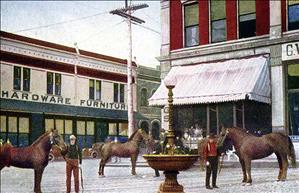On May 1, 1850, Schuyler (1810-1860) and Eliza (1826-1900) Saunders choose a homestead near the confluence of the Newaukum and Chehalis rivers. They are the first non-Indian settlers in the immediate vicinity, though there are a number of other settlements nearby along the Chehalis River. Neither Schuyler nor Eliza have town-building ambitions and the land on which they settle will gain a reputation for its sogginess. But Saunders' Bottom, as it came to be known, would eventually grow into the town of Chehalis with the help of the Northern Pacific Railroad and later settlers' desire to make the town a commercial center.
Complicated Developments
Although the Cowlitz and Upper Chehalis who occupied the area where the Saunders settled had not yet ceded the land to the United States, non-Indians continued to settle the region. The government allowed the settlers to file claims on the land, only resolving the land question with the Upper Chehalis in 1864 and with the Cowlitz in 2002. The Saunders do not seem to have had regular contact or relationships with any of the local Indians.
The story of the Saunders' relationship to the development of Chehalis, Eliza's in particular, is complicated. They lived on their claim for nine years before the next white settlers came to their neighborhood. Obadiah B. McFadden (1814-1875), chief justice of the territorial Supreme Court, and his wife Margaret (b. 1819), bought the southern half of the Saunders' claim in 1859. The house they built on their land still stands and it is the oldest structure in Lewis County.
Eliza's Land
After the McFaddens, more settlers came into the area, but economic development lagged because of the difficulty of transporting goods to market in New Market (later Tumwater). Land in the area tended to be very wet, often marshy and hard to traverse. Not until the Northern Pacific Railroad laid tracks through Eliza Saunders' land in 1872 would there be a reliable means to getting goods to market.
The Northern Pacific Superintendent, J. W. Sprague approached Eliza Saunders (Schuyler had died in 1860) to negotiate a deal for land for a depot on her land. She refused the offer and Sprague purchased land for a depot at Newaukum. Given their physical environment, local settlers who wanted to see a town built in the valley near Saunders' Bottom knew they needed a railroad depot. They proceeded to finagle a depot out of the railroad under the leadership of William West, Obadiah McFadden, and other settlers.
The siting of the railroad depot on Eliza's land placed her in control of how and where the town would develop. Between 1873 and 1892 she slowly platted sections of her land and sold some lots and developed others herself. Two suspicious fires in 1892 nearly leveled the buildings on the land originally owned by her, including the Barrett business block, named after Eliza, who had married and divorced John C. Barrett.
After the fires, development shifted north to Market Street. The Chehalis Land and Timber Company had been developing properties in this area since 1889 and other businesses migrated toward their lots rather than rebuilding in the burned-out areas. Barrett's influence on Chehalis' development declined.

